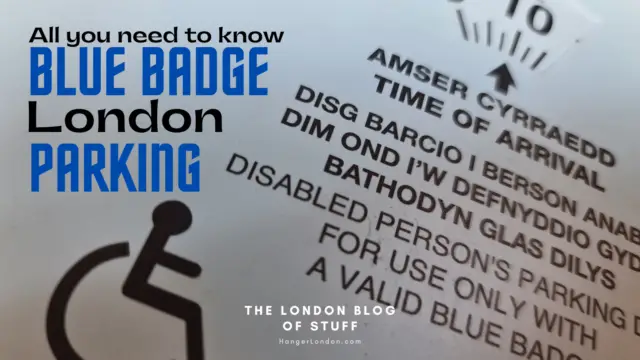The Blue Badge scheme allows badge holders to park closer to their destination, making it easier and more convenient to access shops, attractions, and other amenities. The scheme works well, but how does it work in a big, complex, and often congested city such as London, In this blog post we aim to get to the bottom of using your Blue Badge in London
First a disclaimer: It is the hope of this site to make this piece a work in progress with the help of readers to add their knowledge and experiences in the comments. Parking regulations are complex and subject to change, in researching this post it is quite clear, other than the basic information the real nuances and complexities of the parking regulations are not so readily accessible to the average motorist.
A Quick browse through the highway code will show you the number of different signs and regulations the motorist has to navigate. While care has been taken in writing this post, errors may unknowingly have entered the text. ‘Always!’ go to the council site parking page, linked in this post for the area you are traveling to, you can also phone the associated council parking office. Always take the advice of a government or local government publication, and follow the rules. Enjoy the post, I hope this acts as a signpost and happy parking. If you spot any issues or have queries drop them in the comments section.
The 32 London Boroughs
London is divided into 32 boroughs, each with its own distinct character and identity. These boroughs are responsible for providing local services and amenities, including housing, waste management, and education, as well as enforcing local bylaws and regulations.
Each borough has its own local council, made up of elected councilors who represent the interests of their constituents. While some boroughs are relatively affluent and residential, others are more densely populated and diverse, with bustling high streets, markets, and cultural attractions.
Challenges of parking in London
Parking in London can be a significant challenge, with a number of factors contributing to the difficulties faced by drivers. One of the primary issues is the sheer volume of traffic on the roads, which can lead to congestion and delays, making it difficult to find an available parking space.
Additionally, the limited availability of parking spaces, especially in popular areas such as the West End, or areas of interest.
On top of this, there are also strict parking regulations in place, with many areas designated as residents-only or subject to time restrictions, making it challenging for visitors to find suitable parking options.
The city streets pre-date the car, with narrow lanes, tight turns, and heavy traffic making it challenging to navigate and park safely.
Despite these challenges, there are options available, such as car parks, parking apps, and public transport, which can help drivers to find suitable parking solutions in London.
Rules and Limitations for Blue Badge Holders and Their Concessions
The Blue Badge scheme is designed to provide parking concessions for disabled people to make it easier for them to access services and amenities in the community. However, there are rules that must be followed to ensure the system works effectively.
One of the rules is that if a Blue Badge holder is not present in the vehicle, the driver cannot continue to wait on red lines. This means that if you are being driven by someone else, they cannot wait in the vehicle on red lines while you are not present in the vehicle. This is to prevent misuse of the Blue Badge scheme and ensure that parking spaces are used correctly.
The concessions granted to Blue Badge holders only apply when the badge holder is driving the vehicle or is a passenger in it.
It is also important to note that the driver is not allowed to drop off the Blue Badge holder and then park the vehicle on red lines. The driver must find a suitable parking space outside of the red lines to park the vehicle.
Concessions are exclusive to the Blue Badge holder and cannot be used by anyone else, even if they are performing tasks or running errands for the badge holder. When the badge holder is a passenger, the driver is allowed time to accompany them to their destination, including taking them to nearby premises. The Blue Badge should be displayed during this time.
The Basic Rules of Blue Badge Usage
Having a Blue Badge can be a valuable asset when navigating a city, but it is important to be aware of the rules and regulations that come with it. Here are some key points to keep in mind:
- Always display your badge and clock clearly on the dashboard of the vehicle. This helps to ensure that it is visible to parking attendants and other drivers.
- Never stop where your vehicle will cause an obstruction to traffic or pedestrians. It is important to park in a safe and responsible manner to avoid causing disruptions or hazards to others.
- Never stop on white ‘zig-zag’ markings. These markings indicate areas where parking is prohibited for safety reasons, such as near pedestrian crossings.
- Never park on the pavement (except where signs indicate that this is legal). Parking on the pavement can cause obstructions and create difficulties for pedestrians, particularly those with mobility issues.
- Never park in suspended bays. These are parking spaces that have been temporarily suspended for a variety of reasons, and parking in them is not allowed.
- Be careful to observe the special rules for central London (The City of London, the City of Westminster, Kensington, and Chelsea, and parts of Camden) and Gatwick and Heathrow airports. These areas may have specific parking regulations that differ from other parts of the city.
- Do not park on red routes, unless you are in the signed red route box bays provided. Red routes are major roads in London where stopping is only permitted in certain designated areas.
- Do not allow others to use your blue badge – this is a criminal offence. Blue badges are issued for personal use only and should not be shared or loaned to others.
Parking on a Red Route with a Blue Badge
The London red route is a network of major roads in London that are managed by Transport for London (TfL). These roads are designated as red routes because they are marked with double red lines along the edges of the carriageway, which indicate that stopping or parking is not allowed at any time except in designated bays.
For motorists, this means that there are strict rules in place when it comes to parking or stopping on the red route. Drivers are only permitted to stop or park in designated bays that are marked with white boxes or signs indicating that parking is allowed. Parking on the red route outside of these designated areas can result in fines and penalty points on your driving licence.
However, there are some exceptions to the rules for certain types of vehicles, such as buses and taxis, which are allowed to stop or park in specific areas on the red route. Additionally, as mentioned in the previous answer, Blue Badge holders may be permitted to park on the red route in designated parking bays.
It is important to keep in mind that not all parking bays are designed for general parking. Some bays may be reserved for specific activities, such as loading, or for exclusive use by taxis. Therefore, it is crucial to check the signs and markings on the bay before you park to ensure that you are parking in the appropriate area. This will help you avoid any confusion or potential parking violations.
Blue Badge Parking Bays
Blue Badge parking bays are provided in order to make parking more accessible for users of the Blue Badge parking scheme. These designated bays are an essential part of the red route network in London, as they allow parking to be controlled and more accessible for disabled drivers.
However, the availability of these bays is often limited, and some are only available during specified periods when their use will not cause major disruption to the busy road network. To ensure that all drivers have access to these parking bays, time limits are often put in place at popular locations.
If you are a Blue Badge holder, you may be able to park where you see the ‘Blue Badge Parking’ sign, but it is important to check the sign to see how long you are allowed to stay, as there is usually a maximum of three hours. You may also park in bays where you see the ‘P’ parking sign, but you must leave the bay when it is no longer available for parking use.
Picking up a disabled passenger
If you are picking up a disabled passenger with a Blue Badge, there are specific rules that you must follow. These rules may vary depending on the location and the specific parking regulations in place, but there are some general guidelines to keep in mind.
Firstly, you are allowed to stop on a single or double yellow line for up to three hours if you are dropping off or picking up a Blue Badge holder, but you must display the Blue Badge and make sure that the person you are picking up or dropping off is with you at the time.
You may also be able to park in a disabled parking bay if one is available and display the Blue Badge while you wait for the passenger to arrive. However, you must make sure that you do not exceed the time limit for the parking bay and that you are not causing an obstruction to other vehicles or pedestrians.
It is important to note that you cannot leave your vehicle unattended in a disabled parking bay, even if you are only picking up or dropping off a passenger. You must remain with the vehicle at all times, and the passenger must be with you when you return to the vehicle.
In general, it is always best to check the specific rules and regulations for the location where you will be picking up or dropping off a Blue Badge holder. This will ensure that you are parking legally and safely, while also providing the necessary support and assistance for the disabled passenger.
Penalty Charge Notice (PCN)
A PCN (Penalty Charge Notice) is a charge that is issued to drivers who violate parking or traffic regulations. The amount of the charge can vary depending on the nature of the violation, but typically it is a fixed amount.
In London, the standard PCN charge is currently £130, but this amount can be reduced by 50% if paid within 14 days of the date of issue. However, if the charge is not paid within the specified time frame, it may be increased and could ultimately result in legal action and additional costs. It is important to pay any PCN charges promptly and to comply with all parking and traffic regulations to avoid unnecessary fines or legal penalties.
PCNs can be issued by a Civil Enforcement Officer at the time of the contravention, or by using CCTV cameras that monitor the road network.
Parking website of each of the 32 London Boroughs
Please Note: The City of London, the City of Westminster, Kensington, and Chelsea, and parts of Camden, Gatwick, and Heathrow airports, operate specific exclusions on Blue Badge usage. Read the respective council parking pages for details
- Barking and Dagenham – https://www.lbbd.gov.uk/parking
- Barnet – https://www.barnet.gov.uk/parking
- Bexley – https://www.bexley.gov.uk/services/parking
- Brent – https://www.brent.gov.uk/services-for-residents/parking/
- Bromley – https://www.bromley.gov.uk/parking
- Camden – https://www.camden.gov.uk/parking
- Croydon – https://www.croydon.gov.uk/transportandstreets/parking
- Ealing – https://www.ealing.gov.uk/info/201165/parking
- Enfield – https://new.enfield.gov.uk/services/parking/
- Greenwich – https://www.royalgreenwich.gov.uk/parking
- Hackney – https://hackney.gov.uk/parking
- Hammersmith and Fulham – https://www.lbhf.gov.uk/parking
- Haringey – https://www.haringey.gov.uk/parking-roads-and-travel/parking
- Harrow – https://www.harrow.gov.uk/parking
- Havering – https://www.havering.gov.uk/info/20064/parking
- Hillingdon – https://www.hillingdon.gov.uk/parking
- Hounslow – https://www.hounslow.gov.uk/parking
- Islington – https://www.islington.gov.uk/parking
- Kensington and Chelsea – https://www.rbkc.gov.uk/parking-transport-and-streets/parking
- Kingston upon Thames – https://www.kingston.gov.uk/parking
- Lambeth – https://www.lambeth.gov.uk/parking-transport-and-streets/parking
- Lewisham – https://lewisham.gov.uk/myservices/parking
- Merton – https://www.merton.gov.uk/parking
- Newham – https://www.newham.gov.uk/parking
- Redbridge – https://www.redbridge.gov.uk/parking/
- Richmond upon Thames – https://www.richmond.gov.uk/services/parking
- Southwark – https://www.southwark.gov.uk/parking
- Sutton – https://www.sutton.gov.uk/parking
- Tower Hamlets – https://www.towerhamlets.gov.uk/lgnl/transport_and_streets/parking.aspx
- Waltham Forest – https://www.walthamforest.gov.uk/content/parking
- Wandsworth – https://www.wandsworth.gov.uk/parking
- Westminster – https://www.westminster.gov.uk/parking
Blue Badge PArking References
London Councils Blue Badge Scheme
The Blue Badge Scheme: rights and Responsibilities in England
TFL: Blue Badge (disabled) parking




